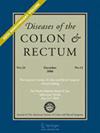What Predicts Complete Response to Total Neoadjuvant Therapy in Locally Advanced Rectal Cancer?
IF 3.2
2区 医学
Q2 GASTROENTEROLOGY & HEPATOLOGY
引用次数: 0
Abstract
BACKGROUND Total neoadjuvant therapy in treatment of stage II-III rectal cancer involves administration of either induction or consolidation chemotherapy with chemoradiation before surgery. Total neoadjuvant therapy is associated with increased complete response rate, which is defined as the proportion of patients who either had pathological complete response after surgery or sustained clinical complete response at least for a year under surveillance. OBJECTIVE To identify the predictors of complete response to total neoadjuvant therapy and compare different diagnostic tools in predicting complete response. DESIGN Retrospective cohort study. SETTINGS A single tertiary-care center. PATIENTS Stage II-III rectal cancer patients who were diagnosed between January 2015 and December 2021. INTERVENTION Total neoadjuvant therapy. MAIN OUTCOME MEASURES Complete response rate, predictors of complete response, sensitivity and specificity of sigmoidoscopy and MRI in predicting complete response. RESULTS One hundred nineteen patients (mean age 56 [±11.3] years, 47 [39.5%] female, 100 [84%] stage III rectal cancer were included. Median tumor size was 5.1 (4-6.5) cm, 63 (52.9%) were low rectal tumors. Twenty-one (17.6%) patients had extramural vascular invasion, 62 (52.1%) had elevated carcinoembryonic antigen at baseline. One hundred eight (90.8%) patients received consolidation chemotherapy. After total neoadjuvant therapy, 88 (73.9%) out of 119 patients underwent surgery, of whom 20 (22.7%) had pathological complete response. Thirty-one (26.1%) patients underwent watch-and-wait, of whom 24 (77.4%) had sustained clinical complete response. Overall complete response rate was 37%. Low rectal tumors (OR 2.6 [95% CI, 1.1-5.9], p = 0.02) and absence of EMVI [OR 5.4 (95% CI, 1.2-25.1), p = 0.01] were predictors of complete response. In predicting complete response, sigmoidoscopy was more sensitive (76.0% vs. 62.5%) and specific (72.5% vs. 69.2%) than MRI. The specificity further increased when 2 techniques were combined (82.5%). LIMITATIONS Retrospective study. CONCLUSIONS Complete response rate after total neoadjuvant therapy was 37%. Low rectal tumors and absence of extramural vascular invasion were predictors of complete response. Sigmoidoscopy was better in predicting incomplete response, whereas combination (MRI and sigmoidoscopy) was better in predicting complete response.如何预测局部晚期直肠癌新辅助疗法的完全反应?
背景在治疗II-III期直肠癌时,新辅助治疗包括在手术前进行诱导化疗或巩固化疗以及化放疗。完全新辅助治疗与完全反应率的提高有关,完全反应率是指术后病理完全反应或临床完全反应至少持续一年并接受监测的患者比例。患者2015年1月至2021年12月期间确诊的II-III期直肠癌患者。主要结局指标完全反应率、完全反应的预测因素、乙状结肠镜检查和磁共振成像在预测完全反应方面的敏感性和特异性。肿瘤中位大小为 5.1(4-6.5)厘米,63 例(52.9%)为低位直肠肿瘤。21名(17.6%)患者有硬膜外血管侵犯,62名(52.1%)患者基线癌胚抗原升高。有18名(90.8%)患者接受了巩固化疗。经过全面的新辅助治疗后,119 名患者中有 88 人(73.9%)接受了手术,其中 20 人(22.7%)获得了病理完全反应。31名(26.1%)患者接受了观察和等待,其中24名(77.4%)患者获得了持续的临床完全反应。总体完全应答率为 37%。低位直肠肿瘤(OR 2.6 [95% CI, 1.1-5.9],P = 0.02)和无 EMVI [OR 5.4 (95% CI, 1.2-25.1),P = 0.01]是预测完全应答的指标。在预测完全反应方面,乙状结肠镜检查的敏感性(76.0% 对 62.5%)和特异性(72.5% 对 69.2%)均高于核磁共振检查。局限性回顾性研究结论新辅助治疗后的完全反应率为37%。低位直肠肿瘤和无壁外血管侵犯是完全反应的预测因素。乙状结肠镜检查更能预测不完全反应,而联合检查(核磁共振成像和乙状结肠镜检查)更能预测完全反应。
本文章由计算机程序翻译,如有差异,请以英文原文为准。
求助全文
约1分钟内获得全文
求助全文
来源期刊
CiteScore
4.50
自引率
7.70%
发文量
572
审稿时长
3-8 weeks
期刊介绍:
Diseases of the Colon & Rectum (DCR) is the official journal of the American Society of Colon and Rectal Surgeons (ASCRS) dedicated to advancing the knowledge of intestinal disorders by providing a forum for communication amongst their members. The journal features timely editorials, original contributions and technical notes.

 求助内容:
求助内容: 应助结果提醒方式:
应助结果提醒方式:


